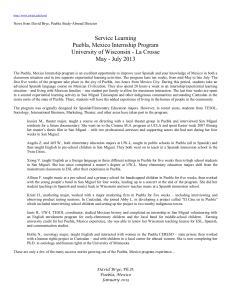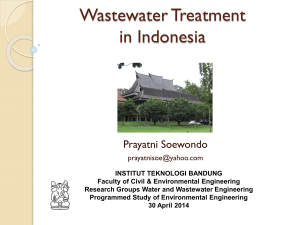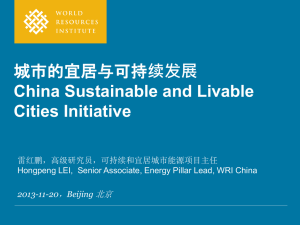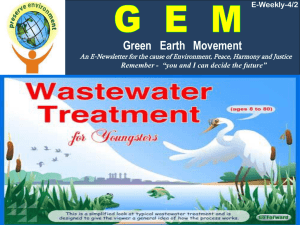Cultural * - University of Chicago
advertisement
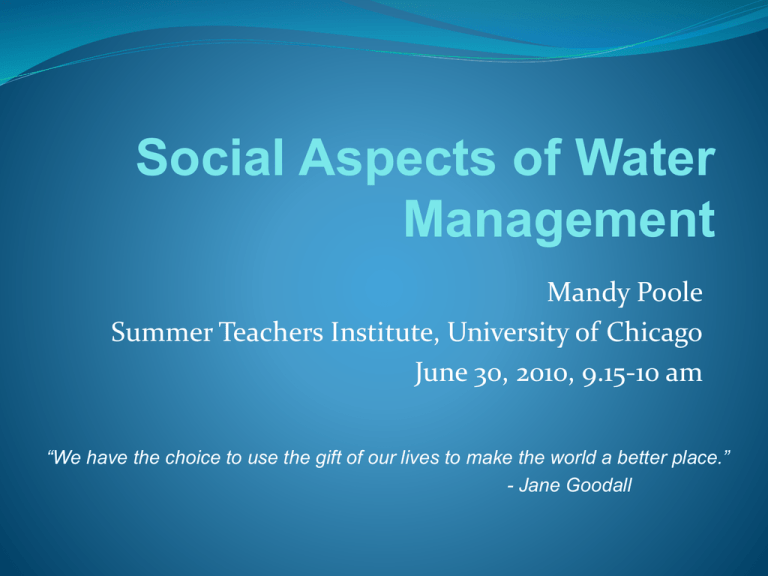
Social Aspects of Water Management Mandy Poole Summer Teachers Institute, University of Chicago June 30, 2010, 9.15-10 am “We have the choice to use the gift of our lives to make the world a better place.” - Jane Goodall My Background University of Illinois B.S. Civil Engineering, 2008 M.S. Environmental Engineering, 2009 Experience Environmental Engineer at Baxter & Woodman, Inc. Why do we care? Human Impact on Industry on Tourism on Quality of Life Environmental Impact on Wildlife on Long-term Resource Protection BP Disaster in the Gulf BP Disaster in the Gulf http://i.telegraph.co.uk/telegraph/multimedia/archive/01653/pelican-waves_1653059c.jpg Nutrient Pollution in Qingdao Port, China http://www.sea-way.org/blog/Qingdao_algae_bloom01.JPG Eutrophication - a process where water bodies receive excess nutrients that stimulate excessive plant growth. Schindler, D.W. “Eutrophication and Recovery in Experimental Lakes: Implications for Lake Management.” Science 24 May 1974. Vol. 184, No. 4139, pp. 897-899. Source: Cohen, Claire. “China’s Blooming Algae Problem that’s Swamping the Olympics.” The Guardian, 3 July 2008. Accessed online via: http://www.dailymail.co.uk/news/worldnews/article-1031444/Chinas-blooming-algaeproblem-thats-swamping-Olympics.html. Source: Cohen, Claire. “China’s Blooming Algae Problem that’s Swamping the Olympics.” The Guardian, 3 July 2008. Accessed online via: http://www.dailymail.co.uk/news/worldnews/article-1031444/Chinas-blooming-algaeproblem-thats-swamping-Olympics.html. Source: http://www.abc.net.au/reslib/200806/r266153_1113036.jpg What is water culture? Culture: “The sum total of ways of living built up by a group of human beings and transmitted from one generation into another” Water Use & Abuse Attitudes toward Water Quantity and Quality Human Health & Hygiene vs. Environmental Health Case Study: Los Llanos, Puebla 2008 Collaboration between Universidad de las Americas, Puebla (UDLAP) University of Illinois – Urbana Champaign (UIUC) Funded by WaterCAMPWS, UIUC, UDLAP Objective of the project: To provide improved water supplies to the community of 84 Case Study: Los Llanos, Puebla No industrial or domestic wastewater treatment Guadalajara – Acutely toxic waterway (by contact) Downstream communities use water for drinking source Manuel Ávila Camacho dam (Built in 1946) Case Study: Los Llanos, Puebla Final Outcome: Built a reservoir to provide storage of river water Submitted a proposal for water treatment Education is paramount Linking sanitation to health The chain-of-responsibility is massive: We need progressive water policy. Community needs to be stakeholders http://www.southwestclimatechange.org/files/cc/figures/drought-status.jpg Reno, Nevada Palm Desert, CA In Chicago… Lake Michigan provides our drinking water Crib pumping facilities located 2-4 miles into the lake Sewer, Water lines usually run parallel Disinfect drinking water instead of fixing pipes Chicago River to be swimmable Resistance to clean-ups Traditional Wastewater Treatment Designed for Solid-Liquid separation. Removal of: Biological and Chemical Oxygen Demand (BOD, COD) Metals (where needed) Pathogens (intermittently treated) Nutrients (nitrogen and phosphorus) Micropollutants The offenders: Personal Care Products (ex. Triclosan, disinfectant) Active Pharmaceutical Ingredients (ex. Hormones) Pesticides Caffeine The effects: Endocrine disruption Feminization of fish (USGS study of Boulder Creek, CO) Products with Triclosan How could we do this better? Regulation at the source of generation: Stop the problem before it starts U.S. EPA agreement with detergent manufacturers has resulted in major reductions in nutrients Paradigm shift by consumers, producers to more responsible chemical management and water protection Need for Creative Solutions The water system that works for us is not the best system for everyone The solutions we use are not always the best ones How do we fix this? Need socially-conscious, open-minded engineers! Need to get away from the $$$ bottom-line approach Always pair water, sanitation, & sustainability Need for Creative Solutions Orange County: Water Factory 21 Drinking water sources: 600 mile aqueduct from Northern California and the Sacramento-San Joaquin Delta 240 mile aqueduct from the Colorado River Water allocation based on high-flows! Underground aquifer replenished by the Santa Ana River, local rainfall, and surplus water from the aqueducts (55% of the total) … and the population continues to grow. Orange County: Water Factory 21 Wastewater “recycling” (i.e. indirect reuse) originally proposed in the early ‘90s “toilet-to-tap” 2004 = program was restarted; now implemented Similar wastewater reuse systems are in place in Singapore and near Washington, D.C. Going Forward We need a paradigm shift in our water culture It’s a privilege, not a right Treat water like the valuable resource it is. Urge for change from above while making sustainable lifestyle choices What can we do? How do we make this a priority? Further Considerations Philosophical debates Is water a basic human right? Why is it not prioritized? Economics Should water be privatized? How do we pay for it? Water Management Encourage TAP water over bottled Rain barrels – lower peak flows to streams, WWTPs Use biodegradable chemicals Properly dispose of PCPs, pharmaceuticals Lower (or eliminate) use of fertilizers, pesticides Encourage installation of low-flow fixtures in new construction (most impact through retrofitting) Push for changes in legislation! Acknowledgements WaterCAMPWS University of Illinois at Urbana – Champaign Baxter & Woodman, Inc. Jamie Bender questions? Mandy Poole alpoole2@gmail.com Mohan, Geoffrey. “Waste water, pay double, L.A. mayor says.” L.A. Times. 14 August 2008. Total Water Withdrawls by Category, 2005 11% 1% 49% 31% 1% 4% 2% 1% Public Supply Domestic Irrigation Livestock Aquaculture Industrial Mining Thermoelectric Source: Kenny, Joan, et al. “Estimated Use of Water in the United States in 2005” Circular 1344. U.S. Geological Survey: Reston, Virginia. 2009.








